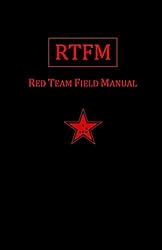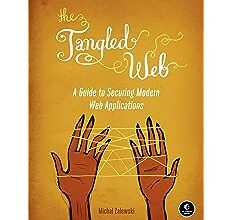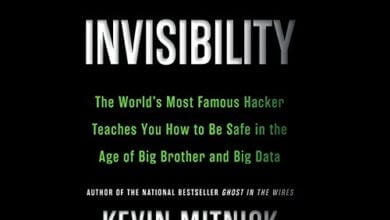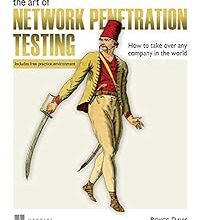
Rating: 4.6/5
In the vast ocean of cybersecurity literature, few books manage to hold their own as consistently as RTFM: Red Team Field Manual by Ben Clark. This time, modest in size but monumental in impact, serves as an essential guide for any ethical hacker, pentester, or cybersecurity enthusiast. But what is it that elevates this manual from a mere reference book to a must-have on every cybersecurity professional’s bookshelf? Let’s delve deeper.
A Comprehensive Command Reference: Tools at Your Fingertips
RTFM: Red Team Field Manual stands out primarily because of its intricate detailing and organization of a vast array of commands. It acts as an encyclopedic reservoir that a red team member might require during an operation. This utility-driven focus ensures that professionals don’t waste valuable time scouring the internet when they need a particular command or a refresher on its usage.
Take, for instance, the commands associated with Windows operations. The manual sheds light on numerous functionalities, from simple tasks such as navigating the directory structure to more complex operations like registry edits or network configurations. An example that resonates with the essence of a red team operation might be the net user command. With this command, one can add, modify, or remove user accounts on a Windows system, providing an invaluable avenue for maneuvering within a target environment. Knowing the intricacies of this command, including its various switches and parameters, can mean the difference between successful exploitation and getting caught in the act.
Similarly, the manual dives deep into the Linux domain, equipping the reader with commands that traverse various functionalities. The nc command, or Netcat, is a Swiss Army knife in the hands of a seasoned hacker. It can be employed for everything from banner grabbing, port scanning, to establishing reverse shells. Familiarity with such commands and their diverse applications enhances a red team member’s efficiency and versatility.
Clark’s genius lies not only in compiling these commands but in presenting them in a manner that’s quickly accessible. The real-world scenarios demand rapid action, where every second can be the difference between success and failure. With RTFM, a user is not just reminded of the syntax but is provided with a context that aids in discerning when and how to deploy a particular command for maximum impact. This dynamism, paired with practical applicability, cements the book’s place as a cherished reference in the arsenal of red team operators.
The Philosophical Underpinnings
One might wonder: Why opt for a manual in the age of search engines and online forums? The answer lies in understanding the philosophy behind red teaming. It’s not just about finding vulnerabilities; it’s about simulating a real-world cyber-attack scenario. In such high-pressure situations, time is of the essence. Being able to reference a command swiftly without trawling through search engine results can be the difference between a successful operation and a failed one.
Moreover, the sheer act of owning and frequently referencing such a manual reinforces a mindset of preparation and thoroughness, which is critical in the field of cybersecurity.
Bridging Theory and Practice:
While RTFM: Red Team Field Manual is primarily a command reference, it subtly educates readers about the broader strategic landscape. Each command, though concise, hints at the broader tactical context in which it is used. The implied scenarios behind these commands offer readers a glimpse into the vast complexity of red team operations.
It is this blend of theory and practice that makes the manual an excellent starting point for beginners while still being a valuable resource for veterans. Beginners get acquainted with the tools and tactics of the trade, while seasoned professionals have a quick reference guide that complements their deep-rooted understanding.
Limitations and the Ever-Evolving Cyber Landscape:
No book, no matter how exceptional, is without its limitations. One of the inherent challenges of writing a manual about a field as dynamic as cybersecurity is keeping it current. The digital landscape is in perpetual evolution, with new vulnerabilities, tools, and techniques emerging regularly. While RTFM: Red Team Field Manual provides a robust foundation, professionals should treat it as a starting point, continually supplementing its content with the latest advancements in the field.
The Broader Implications of Red Teaming: Beyond Simple Hacks
Red teaming, as a concept, transcends beyond just testing the vulnerabilities of a system. At its core, it captures the evolving dynamics of the cyber realm, bringing to light the interplay of tactics, techniques, and procedures used by adversaries in real-world scenarios. RTFM: Red Team Field Manual by Ben Clark is not just a command reference but a testament to the broader scope and implications of red teaming in the vast, intricate world of cybersecurity.
Red teaming serves as an echo of the external threats that businesses, governments, and individuals face on a daily basis. It mimics the methods, mindset, and intent of actual adversaries, providing organizations with a realistic measure of their defenses. While Clark’s manual serves as a resource for technical executions, it indirectly underscores the importance of viewing security from an attacker’s perspective. When organizations conduct or undergo red team assessments, they don’t merely identify technical gaps; they get insights into potential procedural, human, and strategic vulnerabilities.
One of the profound insights from the world of red teaming, reflected in the spirit of RTFM, is the continuous need for adaptability. Cyber threats are not static; they evolve, driven by advancements in technology, changes in geopolitics, and shifts in organizational strategies and structures. A red teamer’s strength lies not just in their knowledge of commands or tools but in their ability to think critically, adapt to novel situations, and develop solutions to unprecedented challenges. Clark’s manual, while technically oriented, serves as a reminder of this ever-evolving landscape. It subtly emphasizes the need to remain updated, not just with commands but with the broader trends and shifts in the cyber domain.
Moreover, the broader implications of red teaming also delve into the ethical realm. Ethical considerations stand paramount, and this is where the lines between a red teamer and a malicious hacker blur yet remain distinctly separate. While both might use similar tools, techniques, and even the commands listed in RTFM, their intentions differ vastly. A red teamer operates within a defined boundary, driven by the objective to strengthen and secure, while a malicious attacker seeks to exploit and harm. Clark’s manual, in its essence, is a tool for empowerment, but it also indirectly emphasizes the responsibility that comes with such knowledge.
In the context of today’s interconnected world, where data breaches and cyber-attacks can have ripple effects impacting economies, political landscapes, and individual lives, the importance of red-teaming is magnified. It’s a proactive approach to security, ensuring that systems aren’t just secure on paper but can withstand the onslaught of determined, intelligent adversaries. RTFM equips professionals with the technical know-how, but the broader narrative surrounding red teaming offers a profound reflection on the state of cybersecurity, the challenges ahead, and the collective responsibility of ensuring a safer digital future.
Final Thoughts: Journeying through RTFM: Red Team Field Manual
In our digital age, a realm punctuated by innovations and challenges, the call for robust cybersecurity solutions has never been louder. Pioneering this endeavor, Ben Clark’s RTFM: Red Team Field Manual has etched its mark as an indispensable asset for those delving into the field of red teaming and, more broadly, cybersecurity.




